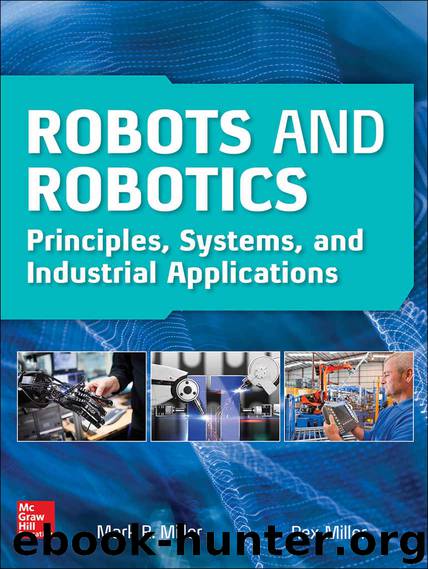Robots and Robotics: Principles, Systems, and Industrial Applications (Electronics) by Rex Miller & Mark Miller

Author:Rex Miller & Mark Miller [Miller, Rex]
Language: eng
Format: azw3
Publisher: McGraw-Hill Education
Published: 2017-07-07T04:00:00+00:00
Serial Ports
The serial format also may be used to transmit data in the ASCII code. Serial ports allow the information to be transmitted along two wires. This makes transmitting over long distances feasible. The parallel-line format is very good for short distances or connection between machines within the same work cell, but if the information has to be sent for a greater distance, it is better to send it by serial formatting.
The information may be transmitted as changes in voltage or changes in current. There are standards for both. In fact, there are two standards for each. The two voltage standards are known as RES-232C and TTL. The two current standards are the 60-milliampere current loop and the 20-milliampere current loop.
The RS232-C standard says that the voltage of the signal will be between −3 and −25 volts to represent the logic 1 or the “on” condition. A voltage between +3 and +25 volts is used to represent the logic 0 or “off” position This standard was developed by the Electronics Industry Association (EIA). The advantage of this standard is that the noise will have to be very high to make any fake signals, and the voltage losses along the line will not affect the signal level as much as lower voltages do. Its disadvantage is that it has to be converted to transistor-transistor logic (TTL) at the port of the computer.
The TTL standard is compatible with transistor-transistor logic and interfaces directly. There are problems with any transmission of data over a distance. If there is a line voltage of at least 0.5 volt, then there is the possibility of receiving incorrect data. Because the peak is only 5 volts, there is always the possibility of picking up a noise signal when a wire is spread over a distance in an electrical noise-generating environment.
The 60-milliampere standard says that a current of 60 milliamperes is logic 1, whereas zero current represents logic 0. The main advantage is that the noise usually encountered over long-distance transmission lines does not affect the quality of the data being transmitted. However, the main disadvantage of this standard is that it has to be converted to voltage variations if used as inputs to a computer port.
The 20-milliampere standard is basically the same as the 60-milliampere standard except that it is 20 milliamperes. The 20-milliampere level represents logic 1, and zero current represents logic 0. The same advantage is experienced with this standard as with the 600-milliampere standard. It is also necessary to convert the current variations to voltage variations if used as inputs to a computer port.
Download
This site does not store any files on its server. We only index and link to content provided by other sites. Please contact the content providers to delete copyright contents if any and email us, we'll remove relevant links or contents immediately.
| Automotive | Engineering |
| Transportation |
Whiskies Galore by Ian Buxton(41712)
Introduction to Aircraft Design (Cambridge Aerospace Series) by John P. Fielding(33011)
Small Unmanned Fixed-wing Aircraft Design by Andrew J. Keane Andras Sobester James P. Scanlan & András Sóbester & James P. Scanlan(32678)
Craft Beer for the Homebrewer by Michael Agnew(18075)
Turbulence by E. J. Noyes(7888)
The Complete Stick Figure Physics Tutorials by Allen Sarah(7258)
Kaplan MCAT General Chemistry Review by Kaplan(6812)
The Thirst by Nesbo Jo(6748)
Bad Blood by John Carreyrou(6468)
Modelling of Convective Heat and Mass Transfer in Rotating Flows by Igor V. Shevchuk(6349)
Learning SQL by Alan Beaulieu(6152)
Weapons of Math Destruction by Cathy O'Neil(6076)
Man-made Catastrophes and Risk Information Concealment by Dmitry Chernov & Didier Sornette(5870)
Digital Minimalism by Cal Newport;(5576)
Life 3.0: Being Human in the Age of Artificial Intelligence by Tegmark Max(5396)
iGen by Jean M. Twenge(5294)
Secrets of Antigravity Propulsion: Tesla, UFOs, and Classified Aerospace Technology by Ph.D. Paul A. Laviolette(5232)
Design of Trajectory Optimization Approach for Space Maneuver Vehicle Skip Entry Problems by Runqi Chai & Al Savvaris & Antonios Tsourdos & Senchun Chai(4949)
Electronic Devices & Circuits by Jacob Millman & Christos C. Halkias(4859)
